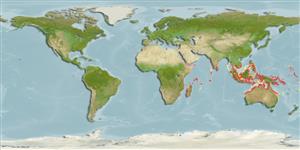Environment: milieu / climate zone / depth range / distribution range
Ecología
marino demersal; rango de profundidad 3 - 30 m (Ref. 90102). Tropical; 15°N - 35°S
Indo-West Pacific: East Africa, Pakistan and India to the Malay Archipelago and the Philippines.
Length at first maturity / Tamaño / Peso / Age
Maturity: Lm 17.9 range ? - ? cm
Max length : 21.3 cm SL macho / no sexado; (Ref. 5297)
Espinas dorsales (total): 0; Radios blandos dorsales (total): 99-108; Espinas anales 0; Radios blandos anales: 77 - 86. Upper side of body brown with black specks; fins dusky; eyed side with 2 lateral lines, none on blind side (Ref. 4418). Rostral hook comparatively long, extending at least to vertical through middle of fixed eye (Ref 9895).
Inhabits sand and silt bottoms in 3-30 m, sometimes near reefs (Ref. 90102).
Menon, A.G.K., 1977. A systematic monograph of the tongue soles of the genus Cynoglossus Hamilton-Buchanan (Pisces: Cynoglossidae). Smithson. Contrib. Zool. (238):1-129. (Ref. 5297)
IUCN Red List Status (Ref. 130435)
Threat to humans
Harmless
Human uses
Pesquerías: escaso valor comercial
Más información
ReferenciasAcuiculturaPerfil de acuiculturaRazasGenéticaElectrophoresesheritabilidadEnfermedadesProcesamientoNutrientsMass conversion
Herramientas
Special reports
Download XML
Fuentes de Internet
Estimates based on models
Preferred temperature (Ref.
123201): 26.2 - 29.3, mean 28.7 °C (based on 1732 cells).
Phylogenetic diversity index (Ref.
82804): PD
50 = 0.5000 [Uniqueness, from 0.5 = low to 2.0 = high].
Bayesian length-weight: a=0.00389 (0.00318 - 0.00476), b=3.07 (3.02 - 3.12), in cm total length, based on LWR estimates for this species (Ref.
93245).
Nivel trófico (Ref.
69278): 3.2 ±0.1 se; based on diet studies.
Resiliencia (Ref.
120179): Alto, población duplicada en un tiempo mínimo inferior a 15 meses (Preliminary K or Fecundity.).
Fishing Vulnerability (Ref.
59153): Low vulnerability (16 of 100).
